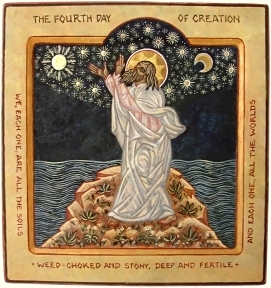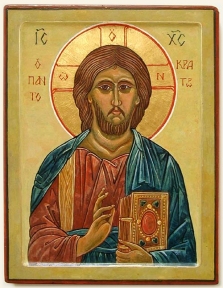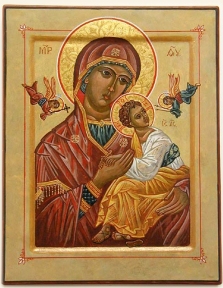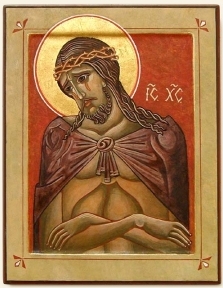| |
Byzantine-Style
Icons
By Betsy Porter
Hope always draws the
soul from the beauty which is seen to what is beyond,
always kindles the desire for the hidden through what is
constantly perceived. Therefore, the ardent lover of
beauty, although receiving what is always visible as an
image of what he desires, yet longs to be filled with
the very stamp of the archetype.
—
Saint Gregory of Nyssa
History and Background
"Icon" means simply "image." The term here refers to
sacred images, specifically those developed in the
Orthodox Christian tradition.
These traditional images have historically been revered
as equivalent in authority to Holy Scripture, as a
visual expression of the Word of God. Some are reputed
to perform healing miracles. Each Orthodox Church is
adorned by an altar screen (iconostasis) covered with
icons, as well as portable icons on stands. An Orthodox
home will typically include a "beautiful corner," where
icons are displayed on a special shelf. Small icons may
function as meditation objects and prayer companions.
More than just sacred art, icons are treated with great
reverence, as part of an active relationship with the
holy.
Icons are strongly rooted in classical Greek and Roman
art. They were developed during the long-lived Byzantine
Empire (330-1453) and its descendant cultures. In recent
years, iconography has attracted increased interest and
many new practitioners. The discipline continues to
evolve as a living art form.
There are numerous icon styles, most prominently Greek,
Russian, and Ethiopian. Most historic examples are
paintings in egg tempera on wood; others are mosaic,
fresco, embroidery, tapestry, precious metals, and
enamel. The most familiar icons are half-figures of
Jesus, Mary holding the Christ Child, angels, saints,
apostles, and prophets. Other types include faces,
full-length figures, traditional group scenes
representing special days in the church calendar, and
illustrations of Bible stories and legends of the
saints.
In iconography, a number of artistic rules and
conventions apply. The underlying drawing is
geometrically structured and proportioned. Color areas
are clearly defined. Figures are elongated, eyes large
and shadowed, eyebrows arched, noses long and straight,
mouths closed, hands gracefully stylized. The forehead
(seat of the intellect) and the collarbone (gateway to
the heart) are emphasized. Both eyes and at least one
ear must be visible to enable the holy figure to see and
hear the viewer. Out of respect for the commandment
against graven images, Orthodox icons avoid strongly
three-dimensional effects. Perspective is flattened or
even inversed.
The image is diagrammatic as well as representational,
floating on a sea of philosophy, theology, and
mathematics. Folds in the garments converge and spiral
into power points; hair curls and waves with the saint's
energies; and increasingly bright layers of highlights
symbolize levels of consciousness. Light comes primarily
from within the figure.
Icons have been described as "windows into heaven" and
as "making the invisible visible." Even though somber
events may be depicted, there is an underlying mood of
confidence, joy, and sometimes a playful humor. The holy
figures are shown in a blessed state, suffused with
golden light. They project an intense psychological
presence, and may seem to return your gaze, or even to
initiate the scrutiny.
Painting (Traditionally Known as "Writing") an Icon
Iconography is both a spiritual practice and a
non-competitive artistic discipline. This work is
undertaken with prayer, in a contemplative atmosphere.
Icons are left unsigned or signed only on the back, as
"by the hand of" the artist.
These sacred images have been lovingly refined over the
centuries, so the iconographer does not attempt to
re-invent them, but to copy them faithfully, clearly,
and expressively. Originality and "self-expression" are
rarely required or appropriate. If a modern saint or
unfamiliar theme is to be depicted, one relies on
precedent insofar as possible, allowing several hours to
prepare a satisfactory drawing. But every iconographer
develops a unique style and approach. The individual
touch is readily visible in minor variations and in
nuances of line quality, detail, highlight, and color.
With concentration and persistence, almost anyone can
learn to paint a beautiful icon.
The Prosopon Method
Although I have taken workshops with several
instructors, I am most strongly drawn to the method of
Vladislav Andrejev and his associates of the Prosopon
School, with whom I have been studying since May 1997.
Andrejev learned this method secretly under the Soviet
regime. It is based primarily on the work of Saint
Andrei Rublev (c. 1370-1430), the famous Russian
iconographer-monk.
This method, in itself devotional and ritualized,
produces a "liturgically correct" icon, using only
natural materials. The process requires a series of
carefully executed steps, each of which takes an hour or
two, for a total of at least 40 hours. Every material
and step is symbolic, and part of a coherent system of
symbolic meanings.
The image is written in 23-karat gold leaf and egg
tempera on a wood board covered with a layer of cloth
and many coats of smooth white gesso, concocted of
chalk, marble dust, and animal-skin glue. Egg tempera
paint is hand-mixed of natural pigments (mostly
pulverized minerals) in an emulsion of egg yolk,
vinegar, and water. These colors will last for
centuries.
Several layers of highlights and transparent washes are
applied over dark background colors. Details and
lettering are added last. The careful technique and
beautiful natural materials are similar to those used by
the Old Masters. The resulting image is marked by
elegant line and detail, an appealing inner glow, subtle
but luminous color effects, and a soft sheen.
My Own Involvement
Although iconography is challenging, it feels natural to
me. I have always taken pleasure in making, looking at,
feeling, living among wonderful things. During my
childhood, my father often took me to Baltimore's
Walters Art Gallery, with its treasures of ancient,
Byzantine, medieval, and renaissance art. Travels to
Italy, Greece, and Russia brought opportunities to see
more icons. My work is also influenced by early 20th
century decorative art, lettering, and book
illustration.
For some years I have been actively engaged in art and
craft, especially fiber arts, silk painting, and bead
jewelry. But it never occurred to me to paint an icon
until 1997, when my friend Grace Evans showed me two
icons she had painted during 6-day intensive workshops
in Philadelphia. They looked to me even more beautiful
than those I had seen in Russia! Grace told me of her
plans for a similar workshop, with Vladislav Andrejev
and his wife Olga as instructors, to take place at
Trinity Episcopal of Princeton, NJ
–
the very church I was then attending.
I enrolled in this workshop. Initially, I felt rather
foolish for spending several hundred dollars and a week
of vacation time just to reproduce a timeworn design.
But this work was not so simple after all. Vladislav's
guidance was soon very welcome. The symbolism and theory
of iconography delighted me. I could never again look at
art the same way! Here was art as it had once been, and
was becoming for me
–
a rich synthesis of the intellectual, aesthetic,
material, and spiritual.
Since then I've taken several more workshops, and have
painted icons on my own. I try to learn a new artistic
or technical skill with each piece, and look forward to
writing increasingly complex images. Some icons are in
my home, and some have been painted as very special
gifts. Several have found a place at my church, St.
Gregory of Nyssa in San Francisco, where they are well
displayed and used. Here a whole community of other
icons surrounds them.
Because this work is so time-consuming, I can produce
only a few pieces each year.
Betsy Porter
email:
betsy.porter@earthlink.net |
|

Fourth Day of Creation
By Betsy Porter
This image was included in the Visual Preludes for
General Convention 2003 and presented on Thursday,
July 31st.

Christ Pantocrator (Ruler of All)
By Betsy Porter
Jesus is typically depicted as teacher and philosopher.
Like other teachers, he typically holds a book. His gaze
is intent, inquiring, both open and inward. His heavenly
blue outer garment and earthy red inner garment
symbolize his dual nature. His unique halo is marked by
a cross and lettering, roughly translatable as "I am who
I am."

Theotokos of the Passion
(Our Lady of Perpetual Help)
By Betsy Porter
In the Theotokos of the Passion, an icon type known in
the West as Our Lady of Perpetual Help, our foreboding
becomes explicit as two angels approach to present the
Christ Child with the instruments of his death. Although
his attention is on the angels and their message, he
clasps his mother's hand for reassurance.

Christ as Man of Sorrows
By Betsy Porter
Here is Jesus in the crown of thorns and purple robe, as
he would have appeared before Pilate. In Orthodox
imagery, Christ never loses his physical beauty. Images
of his passion are presented with only token bleeding
and without the graphically explicit physical suffering
often seen in Western versions.
Icons of Christ's passion take us to our own places of
fear, grief, pain, and horror. Here our beloved Lord, in
severe grief and pain and trouble, stands with us and
for us.
Jesus appears chilled and embarrassed. Pilate's soldiers
made him look really silly in that skimpy purple robe.
The knot seems to symbolize his heart. To emphasize the
drama and tension, I painted the inner background red.
Also by
Betsy Porter
How to Paint an Icon
by the Prosopon Method
For more information on icons, please visit the following links:
ECVA exhibition Icons and Prayers
Prosopon School of Iconology
Icon Arts | |
![]()